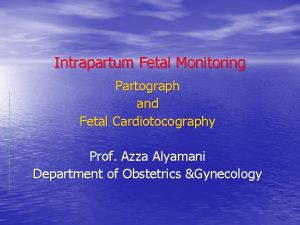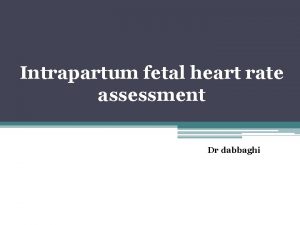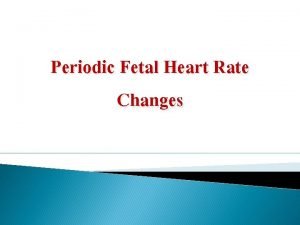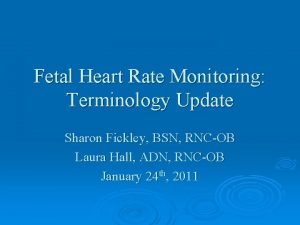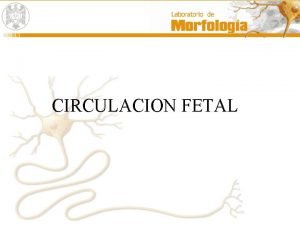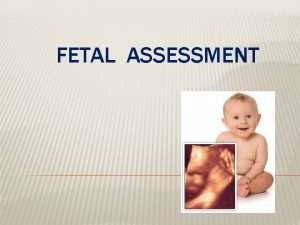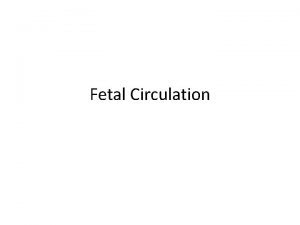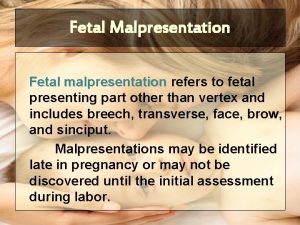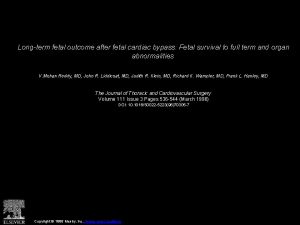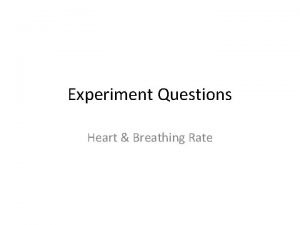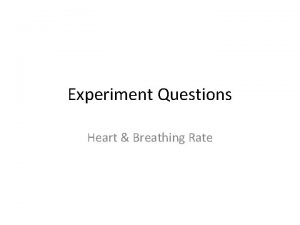Fetal HR Tracings Fetal Heart Rate FHR is


















- Slides: 18

Fetal HR Tracings

Fetal Heart Rate FHR is controlled by the autonomic nervous system. The inhibitory influence on the heart rate is conveyed by the vagus nerve, whereas excitatory influence is conveyed by the sympathetic nervous system. Progressive vagal dominance occurs as the fetus approaches term and, after birth, results in a gradual decrease in the baseline FHR. Stimulation of the peripheral nerves of the fetus by its own activity (such as movement) or by uterine contractions causes acceleration of the FHR. Baroreceptors influence the FHR through the vagus nerve in response to change in fetal blood pressure. Stressful situations in the fetus evoke the baroreceptor reflex, which causes peripheral vasoconstriction and hypertension with a resultant bradycardia. Hypoxia, uterine contractions, fetal head compression result in a similar response. Chemoreceptors located in the aortic and carotid bodies respond to hypoxia, excess carbon dioxide and acidosis, producing tachycardia and hypertension. Normal FHR range is 120 -160 beats per minute (bpm). The baseline rate is interpreted as changed if the alteration persists for more than 15 minutes. Prematurity, maternal anxiety and maternal fever may increase the baseline rate, while fetal maturity decreases the baseline rate.

Late Decelerations Symmetrical fall in FHR beginning at or after the peak of the uterine contraction and returning to baseline only after the contraction has ended. Indicate possible uteroplacental insufficiency, and imply some degree of fetal hypoxia. Repetitive late decelerations and late decelerations with decreased baseline variability are non-reassuring.

Variable Decelerations Acute fall in the FHR with a rapid down slope and variable recovery phase. May or may not have a constant relationship to the uterine contraction pattern. Variable decelerations are non-reassuring when the FHR drops to less than 70 beats per minute (bpm), persists for at least 60 seconds from the beginning to the end of the variable deceleration, and are repetitive. The pattern of variable deceleration consistently related to the contractions with a slow return to FHR baseline is also non-reassuring.

Other Fetal HR Patterns Severe tachycardia: FHR greater than 180 beats per minute. Fetal tachycardia may be a sign of persistent non-reassuring tracing when it lasts longer than 10 minutes and is associated with decreased variability. Mild tachycardia: FHR between 160 - 180 beats per minute. Delivery is not required unless other non-reassuring patterns, such as progressively decreasing Moderate bradycardia: FHR between 80 - 100 beats per minute - often associated with fetal head compression. Delivery is not required unless other non-reassuring patterns, such as progressively decreasing short-term variability. Severe bradycardia: FHR less than 80 beats per minute. Severe bradycardia lasting longer than 3 minutes is an ominous finding and may be associated with fetal acidosis. Prolonged deceleration: isolated abrupt decrease in the FHR to levels below the baseline that last for at least 60 to 90 seconds. The decreases can be caused by any mechanism that leads to fetal hypoxia. Sinusoidal pattern: regular oscillation of the baseline long-term variability with absent short-term variability is an ominous sign that may indicate fetal compromise

Non-reassuring FHR Tracings Persistent non-reassuring tracings indicate the need for emergent delivery. Delivery may include vacuum extraction, forceps, or cesarean delivery, depending upon fetal presentation and the expertise of the attending physician. Cesarean delivery indications include: – persistent late decelerations – severe persistent variable decelerations – severe persistent non-remediable bradycardia – scalp p. H <7. 2 If 1 minute APGAR <3 or 5 minute APGAR <6, cord p. H or gases are recommended. Non-reassuring patterns – Fetal tachycardia – Fetal bradycardia – Saltatory variability – Variable decelerations associated with a non-reassuring pattern – Late decelerations with preserved beat-to-beat variability Ominous patterns – Persistent late decelerations with loss of beat-to-beat variability – Non-reassuring variable decelerations associated with loss of beat-to-beat variability – Prolonged severe bradycardia – Sinusoidal pattern – Confirmed loss of beat-to-beat variability not associated with fetal quiescence, medications or severe prematurity

Fetal Tachycardia Causes of Fetal Tachycardia – – – Fetal hypoxia Maternal fever Hyperthyroidism Maternal or fetal anemia Parasympatholytic drugs Atropine Sympathomimetic drugs Ritodrine (Yutopar) Terbutaline (Bricanyl) Chorioamnionitis Fetal tachyarrhythmia Prematurity

Fetal Bradycardia Causes of Severe Fetal Bradycardia – Prolonged cord compression – Cord prolapse – Tetanic uterine contractions – Paracervical block – Epidural and spinal anesthesia – Maternal seizures – Rapid descent – Vigorous vaginal examination

Nonreassuring Variable Decelerations that Indicate Hypoxemia Increased severity of the deceleration Late onset and gradual return phase Loss of "shoulders" on FHR recording A blunt acceleration or "overshoot" after severe deceleration Unexplained tachycardia Saltatory variability Late decelerations or late return to baseline Decreased variability

FHR Tracings FIGURE 1. Reassuring pattern. Baseline fetal heart rate is 130 to 140 beats per minute (bpm), preserved beat-to-beat and long-term variability. Accelerations last for 15 or more seconds above baseline and peak at 15 or more bpm. (Small square=10 seconds; large square=one minute)

FHR Tracings Figure 2. Saltatory pattern with wide variability. The oscillations of the fetal heart rate above and below the baseline exceed 25 bpm. This pattern is usually caused by acute hypoxia or mechanical compression of the umbilical cord. This pattern is most often seen during the second stage of labor. Although it is a nonreassuring pattern, the saltatory pattern is usually not an indication for immediate delivery.

FHR Tracings FIGURE 3. Fetal tachycardia with possible onset of decreased variability during the second stage of labor. Fetal heart rate is 170 to 180 bpm. Mild variable decelerations are present.

Fetal Tracings FIGURE 4. Fetal tachycardia that is due to fetal tachyarrhythmia associated with congenital anomalies, in this case, ventricular septal defect. Fetal heart rate is 180 bpm. Notice the "spike" pattern of the fetal heart rate.

Fetal Tracings FIGURE 5. Early deceleration in a patient with an unremarkable course of labor. Notice that the onset and the return of the deceleration coincide with the start and the end of the contraction, giving the characteristic mirror image.

Fetal Tracings FIGURE 6. Non-reassuring pattern of late decelerations with preserved beat-to-beat variability. Note the onset at the peak of the uterine contractions and the return to baseline after the contraction has ended. The second uterine contraction is associated with a shallow and subtle late deceleration.

Fetal Tracings FIGURE 7. Late deceleration with loss of variability. This is an ominous pattern, and immediate delivery is indicated.

Fetal Tracings FIGURE 8. Variable deceleration with pre- and post-accelerations ("shoulders"). Fetal heart rate is 150 to 160 beats per minute, and beat-to-beat variability is preserved.

Fetal Tracings Sinusoidal Pattern: rare but ominous, and is associated with high rates of fetal morbidity and mortality. It indicates severe fetal anemia, as occurs in cases of Rh disease or severe hypoxia.
 Lpa certification
Lpa certification Indot level 1 checklist
Indot level 1 checklist Pseudo sinusoidal pattern vs sinusoidal
Pseudo sinusoidal pattern vs sinusoidal Wandering fetal heart rate baseline
Wandering fetal heart rate baseline Veal chop fht
Veal chop fht Pseudo sinusoidal fetal heart rate pattern
Pseudo sinusoidal fetal heart rate pattern Sinusoidal fetal heart rate
Sinusoidal fetal heart rate Abruption contraction pattern
Abruption contraction pattern Dr. c bravado
Dr. c bravado Itu cwg fhr
Itu cwg fhr Perbedaan antara fhr dan dnhr
Perbedaan antara fhr dan dnhr Iupc contraction intensity
Iupc contraction intensity Ilias fhr nrw
Ilias fhr nrw Fetal heart
Fetal heart Premonitiry
Premonitiry Nichd category
Nichd category Fetal pig diagram labeled answers
Fetal pig diagram labeled answers Dullness of heart
Dullness of heart Left atrium sheep heart
Left atrium sheep heart


